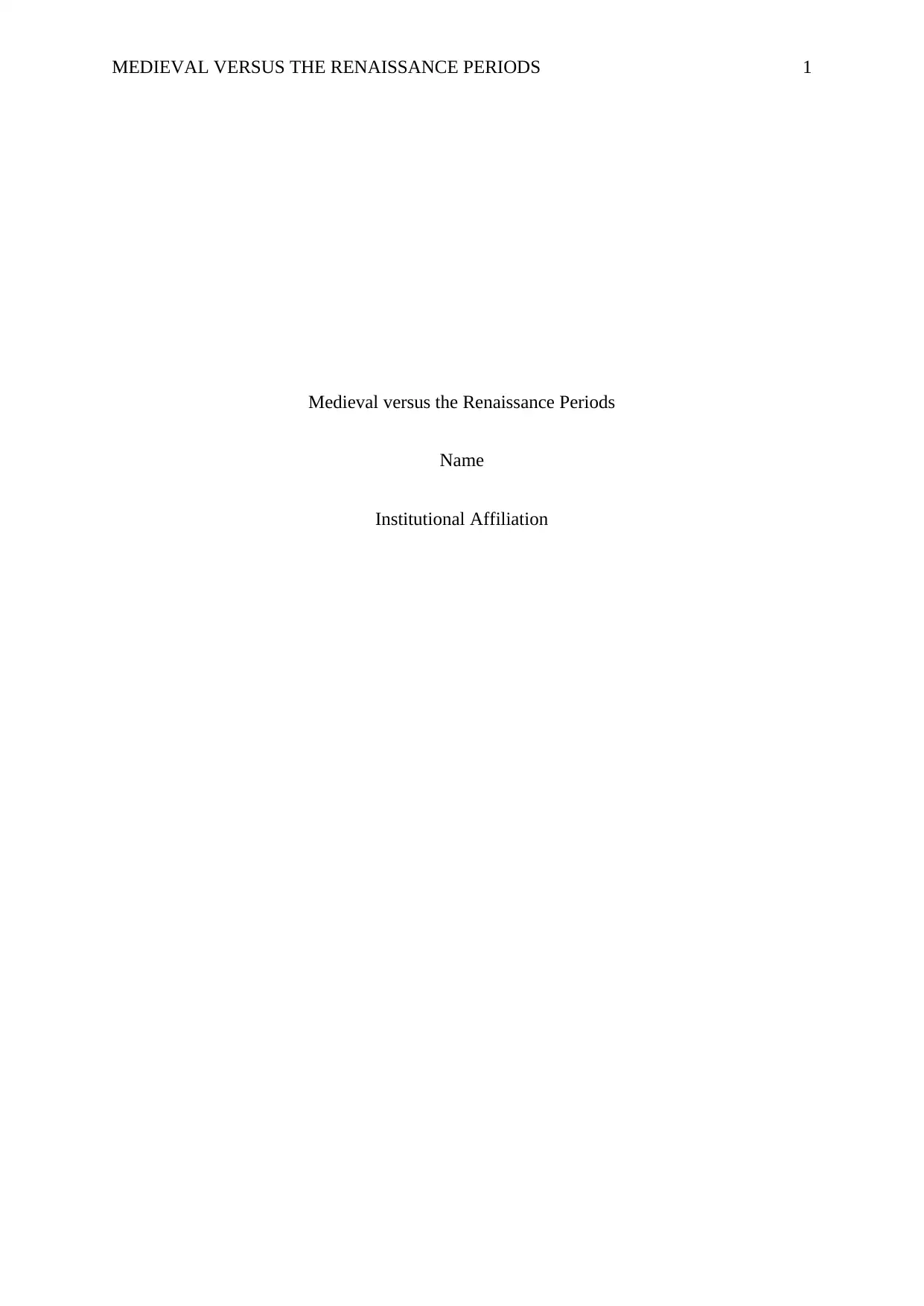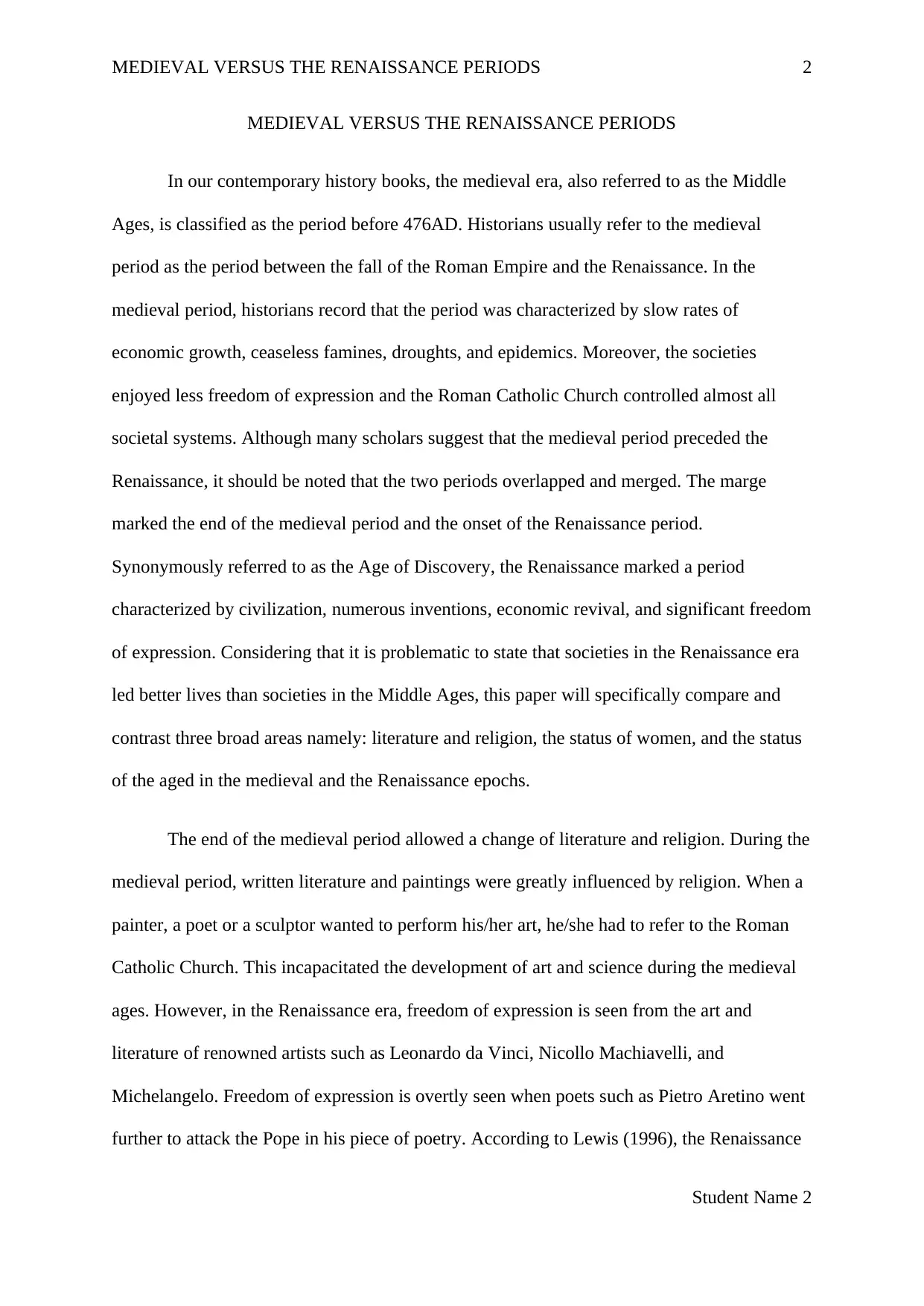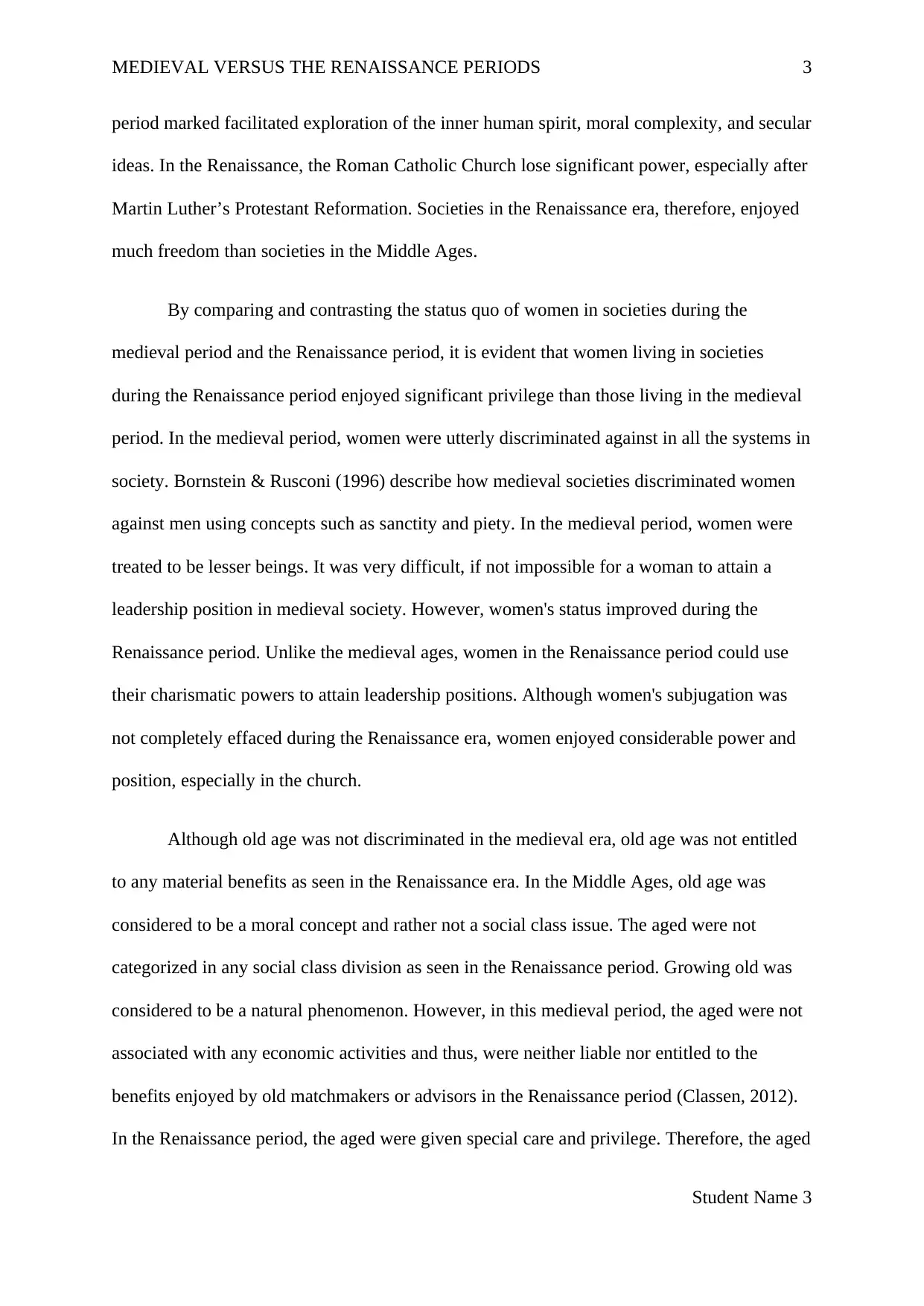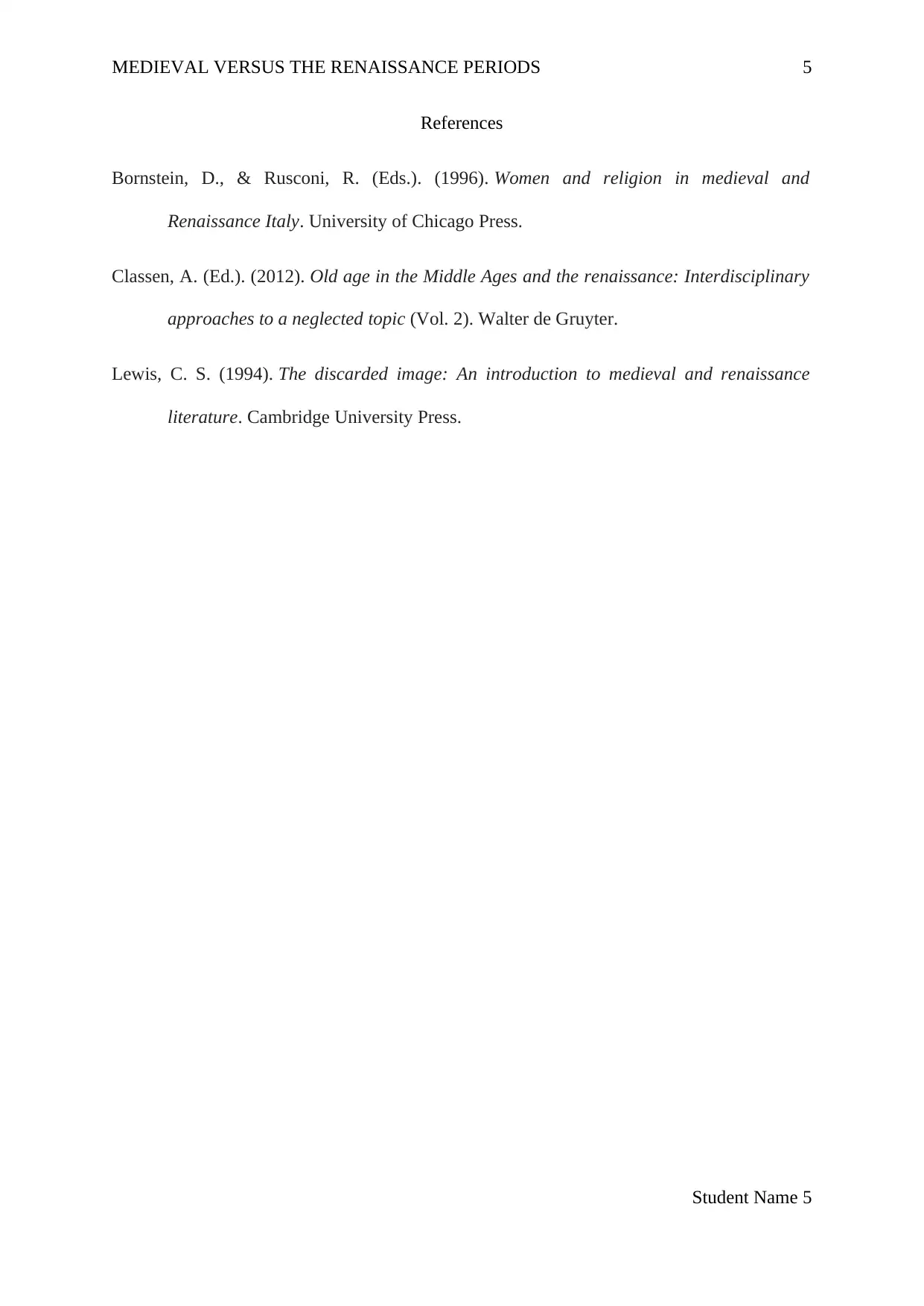A Comparative Analysis of the Medieval and Renaissance Periods
VerifiedAdded on 2022/07/27
|5
|981
|22
Report
AI Summary
This report provides a comparative analysis of the Medieval and Renaissance periods, focusing on key aspects such as literature and religion, the status of women, and the status of the aged. It highlights the shift from religious dominance and limited expression in the Medieval period to the increased freedom and exploration of the Renaissance. The report examines how women faced discrimination in the Middle Ages but gained more power and influence in the Renaissance. Additionally, it contrasts the treatment of the aged, who were not entitled to material benefits in the Medieval period but received special care and privilege during the Renaissance. The conclusion emphasizes that while it's not possible to definitively state that the Renaissance was better, it offered more opportunities based on the evidence presented. References include works by Lewis, Bornstein & Rusconi, and Classen.

MEDIEVAL VERSUS THE RENAISSANCE PERIODS 1
Medieval versus the Renaissance Periods
Name
Institutional Affiliation
Medieval versus the Renaissance Periods
Name
Institutional Affiliation
Paraphrase This Document
Need a fresh take? Get an instant paraphrase of this document with our AI Paraphraser

MEDIEVAL VERSUS THE RENAISSANCE PERIODS 2
MEDIEVAL VERSUS THE RENAISSANCE PERIODS
In our contemporary history books, the medieval era, also referred to as the Middle
Ages, is classified as the period before 476AD. Historians usually refer to the medieval
period as the period between the fall of the Roman Empire and the Renaissance. In the
medieval period, historians record that the period was characterized by slow rates of
economic growth, ceaseless famines, droughts, and epidemics. Moreover, the societies
enjoyed less freedom of expression and the Roman Catholic Church controlled almost all
societal systems. Although many scholars suggest that the medieval period preceded the
Renaissance, it should be noted that the two periods overlapped and merged. The marge
marked the end of the medieval period and the onset of the Renaissance period.
Synonymously referred to as the Age of Discovery, the Renaissance marked a period
characterized by civilization, numerous inventions, economic revival, and significant freedom
of expression. Considering that it is problematic to state that societies in the Renaissance era
led better lives than societies in the Middle Ages, this paper will specifically compare and
contrast three broad areas namely: literature and religion, the status of women, and the status
of the aged in the medieval and the Renaissance epochs.
The end of the medieval period allowed a change of literature and religion. During the
medieval period, written literature and paintings were greatly influenced by religion. When a
painter, a poet or a sculptor wanted to perform his/her art, he/she had to refer to the Roman
Catholic Church. This incapacitated the development of art and science during the medieval
ages. However, in the Renaissance era, freedom of expression is seen from the art and
literature of renowned artists such as Leonardo da Vinci, Nicollo Machiavelli, and
Michelangelo. Freedom of expression is overtly seen when poets such as Pietro Aretino went
further to attack the Pope in his piece of poetry. According to Lewis (1996), the Renaissance
Student Name 2
MEDIEVAL VERSUS THE RENAISSANCE PERIODS
In our contemporary history books, the medieval era, also referred to as the Middle
Ages, is classified as the period before 476AD. Historians usually refer to the medieval
period as the period between the fall of the Roman Empire and the Renaissance. In the
medieval period, historians record that the period was characterized by slow rates of
economic growth, ceaseless famines, droughts, and epidemics. Moreover, the societies
enjoyed less freedom of expression and the Roman Catholic Church controlled almost all
societal systems. Although many scholars suggest that the medieval period preceded the
Renaissance, it should be noted that the two periods overlapped and merged. The marge
marked the end of the medieval period and the onset of the Renaissance period.
Synonymously referred to as the Age of Discovery, the Renaissance marked a period
characterized by civilization, numerous inventions, economic revival, and significant freedom
of expression. Considering that it is problematic to state that societies in the Renaissance era
led better lives than societies in the Middle Ages, this paper will specifically compare and
contrast three broad areas namely: literature and religion, the status of women, and the status
of the aged in the medieval and the Renaissance epochs.
The end of the medieval period allowed a change of literature and religion. During the
medieval period, written literature and paintings were greatly influenced by religion. When a
painter, a poet or a sculptor wanted to perform his/her art, he/she had to refer to the Roman
Catholic Church. This incapacitated the development of art and science during the medieval
ages. However, in the Renaissance era, freedom of expression is seen from the art and
literature of renowned artists such as Leonardo da Vinci, Nicollo Machiavelli, and
Michelangelo. Freedom of expression is overtly seen when poets such as Pietro Aretino went
further to attack the Pope in his piece of poetry. According to Lewis (1996), the Renaissance
Student Name 2

MEDIEVAL VERSUS THE RENAISSANCE PERIODS 3
period marked facilitated exploration of the inner human spirit, moral complexity, and secular
ideas. In the Renaissance, the Roman Catholic Church lose significant power, especially after
Martin Luther’s Protestant Reformation. Societies in the Renaissance era, therefore, enjoyed
much freedom than societies in the Middle Ages.
By comparing and contrasting the status quo of women in societies during the
medieval period and the Renaissance period, it is evident that women living in societies
during the Renaissance period enjoyed significant privilege than those living in the medieval
period. In the medieval period, women were utterly discriminated against in all the systems in
society. Bornstein & Rusconi (1996) describe how medieval societies discriminated women
against men using concepts such as sanctity and piety. In the medieval period, women were
treated to be lesser beings. It was very difficult, if not impossible for a woman to attain a
leadership position in medieval society. However, women's status improved during the
Renaissance period. Unlike the medieval ages, women in the Renaissance period could use
their charismatic powers to attain leadership positions. Although women's subjugation was
not completely effaced during the Renaissance era, women enjoyed considerable power and
position, especially in the church.
Although old age was not discriminated in the medieval era, old age was not entitled
to any material benefits as seen in the Renaissance era. In the Middle Ages, old age was
considered to be a moral concept and rather not a social class issue. The aged were not
categorized in any social class division as seen in the Renaissance period. Growing old was
considered to be a natural phenomenon. However, in this medieval period, the aged were not
associated with any economic activities and thus, were neither liable nor entitled to the
benefits enjoyed by old matchmakers or advisors in the Renaissance period (Classen, 2012).
In the Renaissance period, the aged were given special care and privilege. Therefore, the aged
Student Name 3
period marked facilitated exploration of the inner human spirit, moral complexity, and secular
ideas. In the Renaissance, the Roman Catholic Church lose significant power, especially after
Martin Luther’s Protestant Reformation. Societies in the Renaissance era, therefore, enjoyed
much freedom than societies in the Middle Ages.
By comparing and contrasting the status quo of women in societies during the
medieval period and the Renaissance period, it is evident that women living in societies
during the Renaissance period enjoyed significant privilege than those living in the medieval
period. In the medieval period, women were utterly discriminated against in all the systems in
society. Bornstein & Rusconi (1996) describe how medieval societies discriminated women
against men using concepts such as sanctity and piety. In the medieval period, women were
treated to be lesser beings. It was very difficult, if not impossible for a woman to attain a
leadership position in medieval society. However, women's status improved during the
Renaissance period. Unlike the medieval ages, women in the Renaissance period could use
their charismatic powers to attain leadership positions. Although women's subjugation was
not completely effaced during the Renaissance era, women enjoyed considerable power and
position, especially in the church.
Although old age was not discriminated in the medieval era, old age was not entitled
to any material benefits as seen in the Renaissance era. In the Middle Ages, old age was
considered to be a moral concept and rather not a social class issue. The aged were not
categorized in any social class division as seen in the Renaissance period. Growing old was
considered to be a natural phenomenon. However, in this medieval period, the aged were not
associated with any economic activities and thus, were neither liable nor entitled to the
benefits enjoyed by old matchmakers or advisors in the Renaissance period (Classen, 2012).
In the Renaissance period, the aged were given special care and privilege. Therefore, the aged
Student Name 3
⊘ This is a preview!⊘
Do you want full access?
Subscribe today to unlock all pages.

Trusted by 1+ million students worldwide

MEDIEVAL VERSUS THE RENAISSANCE PERIODS 4
in the Renaissance period enjoyed better standards of living compared to their ancestors that
had lived in the medieval period.
To conclude, based on literature and religion, the status of women, and the status of
the aged, societies living in the Renaissance era enjoyed a considerable improvement in their
living standards as compared to societies in medieval periods. Freedom of expression in
literature, incorporation of women in leadership roles, and privileging the older members of
the society are some of the improvements in the Renaissance era. Although it may be
incorrect to assume that societies in the Renaissance led better lives or vice-versa, the
evidence from the three aforementioned basis points proves that during the Renaissance
period, societies were exposed to more opportunities than in the medieval era.
Student Name 4
in the Renaissance period enjoyed better standards of living compared to their ancestors that
had lived in the medieval period.
To conclude, based on literature and religion, the status of women, and the status of
the aged, societies living in the Renaissance era enjoyed a considerable improvement in their
living standards as compared to societies in medieval periods. Freedom of expression in
literature, incorporation of women in leadership roles, and privileging the older members of
the society are some of the improvements in the Renaissance era. Although it may be
incorrect to assume that societies in the Renaissance led better lives or vice-versa, the
evidence from the three aforementioned basis points proves that during the Renaissance
period, societies were exposed to more opportunities than in the medieval era.
Student Name 4
Paraphrase This Document
Need a fresh take? Get an instant paraphrase of this document with our AI Paraphraser

MEDIEVAL VERSUS THE RENAISSANCE PERIODS 5
References
Bornstein, D., & Rusconi, R. (Eds.). (1996). Women and religion in medieval and
Renaissance Italy. University of Chicago Press.
Classen, A. (Ed.). (2012). Old age in the Middle Ages and the renaissance: Interdisciplinary
approaches to a neglected topic (Vol. 2). Walter de Gruyter.
Lewis, C. S. (1994). The discarded image: An introduction to medieval and renaissance
literature. Cambridge University Press.
Student Name 5
References
Bornstein, D., & Rusconi, R. (Eds.). (1996). Women and religion in medieval and
Renaissance Italy. University of Chicago Press.
Classen, A. (Ed.). (2012). Old age in the Middle Ages and the renaissance: Interdisciplinary
approaches to a neglected topic (Vol. 2). Walter de Gruyter.
Lewis, C. S. (1994). The discarded image: An introduction to medieval and renaissance
literature. Cambridge University Press.
Student Name 5
1 out of 5
Your All-in-One AI-Powered Toolkit for Academic Success.
+13062052269
info@desklib.com
Available 24*7 on WhatsApp / Email
![[object Object]](/_next/static/media/star-bottom.7253800d.svg)
Unlock your academic potential
Copyright © 2020–2025 A2Z Services. All Rights Reserved. Developed and managed by ZUCOL.


